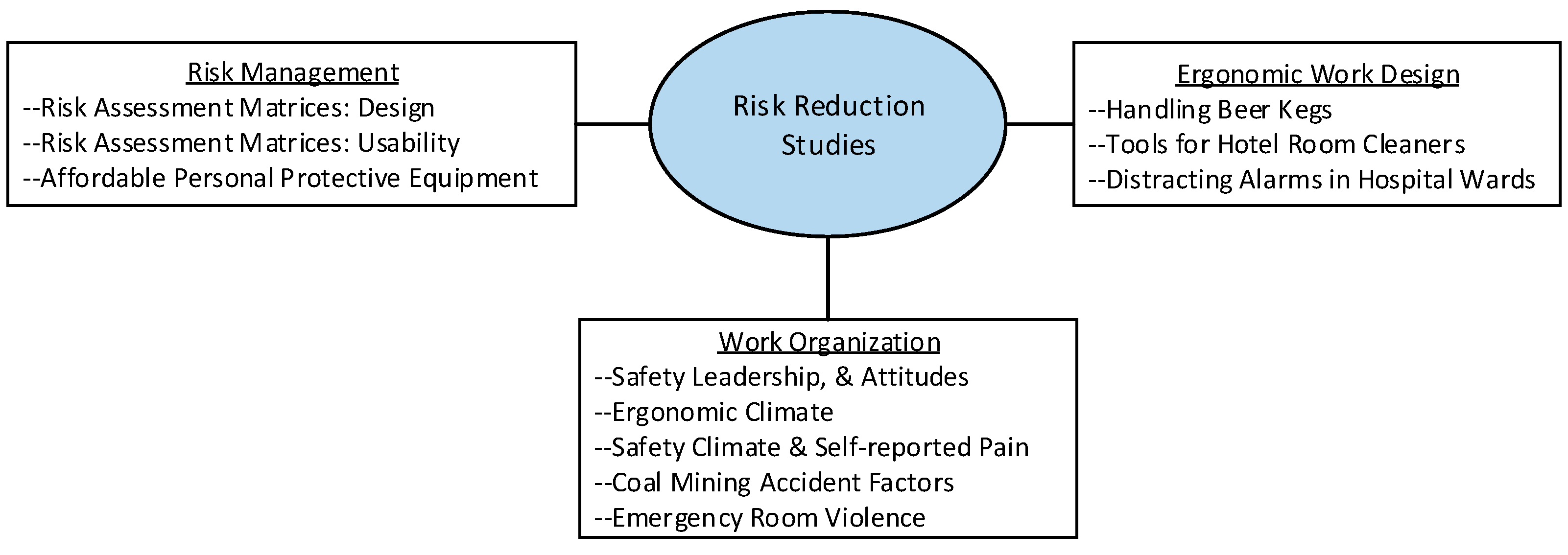Risk-Reduction Research in Occupational Safety and Ergonomics: An Editorial
1. Introduction
2. Risk Management Approaches
3. Work Organization Approaches
4. Ergonomic Work Design
5. Conclusions
Author Contributions
Funding
Conflicts of Interest
References
- Jensen, R.C.; Hansen, H. Selecting appropriate words for naming the rows and columns of risk assessment matrices. Int. J. Environ. Res. Public Health 2020, 17, 5521. [Google Scholar] [CrossRef] [PubMed]
- Jensen, R.C.; Bird, R.L.; Nichols, B.W. Risk assessment matrices for workplace hazards: Design for usability. Int. J. Environ. Res. Public Health 2022, 19, 2763. [Google Scholar] [CrossRef] [PubMed]
- Naksata, M.; Watcharapasorn, A.; Hongsibsong, S.; Sapbamrer, R. Development of personal protective clothing for reducing exposure to insecticides in pesticide application. Int. J. Environ. Res. Public Health 2020, 17, 3303. [Google Scholar] [CrossRef] [PubMed]
- Basahel, A.M. Safety leadership, safety attitudes, safety knowledge and motivation toward safety-related behaviors in electrical substation construction projects. Int. J. Environ. Res. Public Health 2021, 18, 4196. [Google Scholar] [CrossRef] [PubMed]
- Faez, E.; Zakerian, S.A.; Azam, K.; Hancock, K.; Rosecrance, J. An assessment of ergonomics climate and its association with self-reported pain, organizational performance and employee well-being. Int. J. Environ. Res. Public Health 2021, 18, 2610. [Google Scholar] [CrossRef] [PubMed]
- Balogun, A.O.; Smith, T.D. Musculoskeletal symptoms among stone, sand, and gravel mine workers and associations with sociodemographic and job-related factors. Int. J. Environ. Res. Public Health 2020, 17, 3512. [Google Scholar] [CrossRef] [PubMed]
- Fa, Z.; Li, X.; Liu, Q.; Qiu, Z.; Zhai, Z. Correlation in causality: A progressive study of hierarchical relations within human and organizational factors in coal mine accidents. Int. J. Environ. Res. Public Health 2021, 18, 5020. [Google Scholar] [CrossRef] [PubMed]
- McGuire, S.S.; Mullan, A.F.; Clements, C.M. Workplace violence in the emergency department: Case study on staff and law enforcement disagreement on reportable crimes. Int. J. Environ. Res. Public Health 2022, 19, 6818. [Google Scholar] [CrossRef] [PubMed]
- Brents, C.; Hischke, M.; Reiser, R.; Rosecrance, J. Trunk posture during manual materials handling of beer kegs. Int. J. Environ. Res. Public Health 2021, 18, 7380. [Google Scholar] [CrossRef] [PubMed]
- Allread, W.G.; Vossenas, P.V. Comparisons of trunk motions and low back injury risk between alternative hotel cleaning methods. Int. J. Environ. Res. Public Health 2022, 19, 14907. [Google Scholar] [CrossRef] [PubMed]
- Rypiez, L.; Rozensztrauch, A.; Fedorowicz, O.; Włodarczyk, A.; Zatońska, K.; Juárez-Vala, R.; Witczak, I. Polish adaptation of the Alarm Fatigue Assessment Questionnaire as an element of improving patient safety. Int. J. Environ. Res. Public Health 2023, 20, 1734. [Google Scholar] [CrossRef]

Disclaimer/Publisher’s Note: The statements, opinions and data contained in all publications are solely those of the individual author(s) and contributor(s) and not of MDPI and/or the editor(s). MDPI and/or the editor(s) disclaim responsibility for any injury to people or property resulting from any ideas, methods, instructions or products referred to in the content. |
© 2023 by the authors. Licensee MDPI, Basel, Switzerland. This article is an open access article distributed under the terms and conditions of the Creative Commons Attribution (CC BY) license (https://creativecommons.org/licenses/by/4.0/).
Share and Cite
Jensen, R.; Gilkey, D.P. Risk-Reduction Research in Occupational Safety and Ergonomics: An Editorial. Int. J. Environ. Res. Public Health 2023, 20, 5212. https://doi.org/10.3390/ijerph20065212
Jensen R, Gilkey DP. Risk-Reduction Research in Occupational Safety and Ergonomics: An Editorial. International Journal of Environmental Research and Public Health. 2023; 20(6):5212. https://doi.org/10.3390/ijerph20065212
Chicago/Turabian StyleJensen, Roger, and David P. Gilkey. 2023. "Risk-Reduction Research in Occupational Safety and Ergonomics: An Editorial" International Journal of Environmental Research and Public Health 20, no. 6: 5212. https://doi.org/10.3390/ijerph20065212
APA StyleJensen, R., & Gilkey, D. P. (2023). Risk-Reduction Research in Occupational Safety and Ergonomics: An Editorial. International Journal of Environmental Research and Public Health, 20(6), 5212. https://doi.org/10.3390/ijerph20065212





